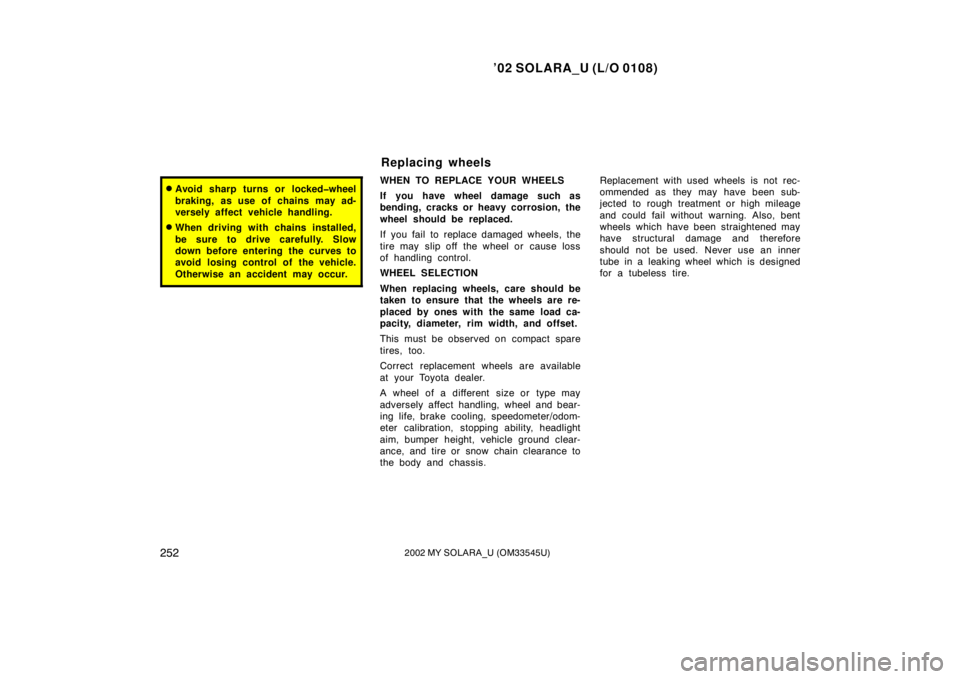Page 185 of 290

’02 SOLARA_U (L/O 0108)
1812002 MY SOLARA_U (OM33545U)
Effective way to press the ABS brake
pedal: When the anti −lock brake system
function is in action, you may feel the
brake pedal pulsating and hear a noise.
In this situation, to let the anti −lock
brake system work for you, just hold the
brake pedal down more firmly. Do not
pump the brake in a panic stop. This
will result in reduced braking performan-
ce.
The anti −lock brake system becomes op-
erative after the vehicle has accelerated
to a speed in excess of approximately 10
km/h (6 mph). It stops operating when the
vehicle decelerates to a speed below
approximately 5 km/h (3 mph).
Depressing the brake pedal on slippery
road surfaces such as on the manhole
cover, the steel plate under the construc-
tion, joints in the bridge, etc. on a rainy
day tends to activate the anti −lock brake
system.
You may hear a click or motor sound in
the engine compartment for a few seconds
when the engine is started or just after
the vehicle is started. This means that the
anti −lock brake system is in the self −
check mode, and does not indicate a mal-
function. When the anti�lock brake system is ac-
tivated, the following conditions may
occur. They do not indicate a malfunc-
tion of the system:
�You may hear the anti
−lock brake sys-
tem operating and feel the brake pedal
pulsating and the vibrations of the ve-
hicle body and steering wheel. You
may also hear the motor sound in the
engine compartment even after the ve-
hicle is stopped.
�At the end of the anti −lock brake sys-
tem activation, the brake pedal may
move a little forward.
CAUTION
Do not overestimate the anti�lock
brake system: Although the anti�lock
brake system assists in providing ve-
hicle control, it is still important to
drive with all due care and maintain
a moderate speed and safe distance
from the vehicle in front of you, be-
cause there are limits to the vehicle
stability and effectiveness of steering
wheel operation even with the anti�
lock brake system on.
If tires grip performance exceeds its
capability, or if hydroplaning occurs
during high speed driving in the rain,
the anti�lock brake system does not
provide vehicle control.
Anti�lock brake system is not de-
signed to shorten the stopping dis-
tance: Always drive at the moderate
speed and maintain a safe distance
from the vehicle in front of you.
Compared with vehicles without an
anti�lock brake system, your vehicle
may require a longer stopping dis-
tance in the following cases:
�Driving on rough, gravel or snow�
covered roads.
�Driving with tire chains installed.
�Driving over the steps such as the
joints on the road.
�Driving on roads where the road
surface is pitted or has other differ-
ences in surface height.
Page 192 of 290

’02 SOLARA_U (L/O 0108)
1882002 MY SOLARA_U (OM33545U)
1. Check the area around the vehicle be-
fore entering it.
2. Adjust seat position, seatback angle, seat cushion height, head restraint
height and steering wheel angle.
3. Adjust the inside and outside rear view mirrors.
4. Lock both doors.
5. Fasten seat belts. 1. Apply the parking brake firmly.
2. Turn off unnecessary lights and acces-
sories.
3. Manual transmission: Press the clutch
pedal to the floor and shift the trans-
mission into neutral. Hold the clutch
pedal to the floor until the engine is
started. A starter safety device will pre-
vent the starter from operating if the
clutch pedal is not fully depressed.
Automatic transmission: Put the se-
lector lever in “P”. If you need to re-
start the engine while the vehicle is
moving, put the selector lever in “N”.
A starter safety device will prevent the
starter from operating if the selector
lever is in any drive position.
4. Automatic transmission only: De-
press the brake pedal and hold it to
the floor until driving off. Before starting the engine, be sure to fol-
low the instructions in “(a) Before crank-
ing”.
Normal starting procedure
The multiport fuel injection system/sequen-
tial multiport fuel injection system in your
engine automatically controls the proper
air
−fuel mixture for starting. You can start
a cold or hot engine as follows:
1. With your foot off the accelerator ped- al, crank the engine by turning the key
to “START”. Release it when the en-
gine starts.
2. After the engine runs for about 10 se- conds, you are ready to drive.
If the weather is below freezing, let the
engine warm up for a few minutes before
driving.
If the engine stalls...
Simply restart it, using the correct proce-
dure given in normal starting.
If the engine will not start...
See “If your vehicle will not start” in Sec-
tion 4.
Before starting the engine H o w to st art th e en g in e—
(a) Before cranking
(b) Starting the engine
Page 256 of 290

’02 SOLARA_U (L/O 0108)
2522002 MY SOLARA_U (OM33545U)
�Avoid sharp turns or locked�wheel
braking, as use of chains may ad-
versely affect vehicle handling.
�When driving with chains installed,
be sure to drive carefully. Slow
down before entering the curves to
avoid losing control of the vehicle.
Otherwise an accident may occur.
WHEN TO REPLACE YOUR WHEELS
If you have wheel damage such as
bending, cracks or heavy corrosion, the
wheel should be replaced.
If you fail to replace damaged wheels, the
tire may slip off the wheel or cause loss
of handling control.
WHEEL SELECTION
When replacing wheels, care should be
taken to ensure that the wheels are re-
placed by ones with the same load ca-
pacity, diameter, rim width, and offset.
This must be observed on compact spare
tires, too.
Correct replacement wheels are available
at your Toyota dealer.
A wheel of a different size or type may
adversely affect handling, wheel and bear-
ing life, brake cooling, speedometer/odom-
eter calibration, stopping ability, headlight
aim, bumper height, vehicle ground clear-
ance, and tire or snow chain clearance to
the body and chassis. Replacement with used wheels is not rec-
ommended as they may have been sub-
jected to rough treatment or high mileage
and could fail without warning. Also, bent
wheels which have been straightened may
have structural damage and therefore
should not be used. Never use an inner
tube in a leaking wheel which is designed
for a tubeless tire.
Replacing wheels
Page 274 of 290
’02 SOLARA_U (L/O 0108)
2702002 MY SOLARA_U (OM33545U)
Model:
2AZ− FE and 1MZ −FE
Type: 2AZ− FE engine
4 cylinder in line, 4 cycle, gasoline
1MZ −FE engine
6 cylinder V type 4 cycle, gasoline
Bore and stroke, mm (in.): 2AZ− FE engine
88.5 �96.0 (3.48 �3.78)
1MZ −FE engine
87.5 �83.0 (3.44 �3.27)
Displacement, cm
3 (cu. in.):
2AZ− FE engine
2362 (144.1)
1MZ −FE engine
2995 (182.8)
Dimensions and weight
4865 (191.5)
1805 (71.1)
1425 (56.1)
∗
1520 (59.8)
Overall length mm (in.)
Overall width mm (in.)
Overall height mm (in.)
Wheelbase mm (in.)
Front tread mm (in.)
Rear tread mm (in.)
Vehicle capacity weight
(occupants + luggage) kg (lb.)2670 (105.1)
1545 (60.8)
340 (750)
∗: Unladen vehicle
4865 (191.5)
1805 (71.1)
1400 (55.1)
∗
1520 (59.8) 2670 (105.1)
1545 (60.8)410 (900)
Coupe Convertible
Engine